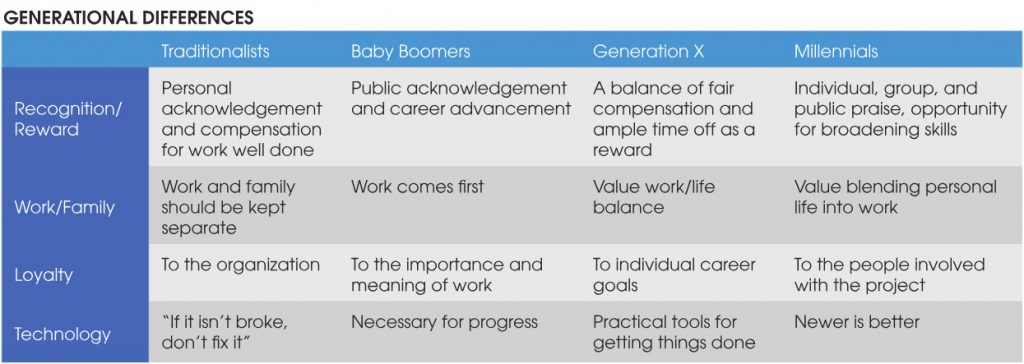While they have been around for years, millennials seem to be all the buzz in the workplace these days. What do millennials want in the workplace? What do they want from work in general? How are they different from other generations? And, the most common question this author has heard, how does one even communicate with millennials? To answer these questions, it is important to start with some basics.
Just like every generation, millennials have their own set of characteristics. They do tend to think, listen, and learn
This is the first time there
Now you are talking
Communication—this one word is very important to every part of a company. In fact, effective communication is key in almost every aspect of daily life. Without it, people become disconnected, begin to make assumptions, and have to put in a lot more effort than necessary just to get some of the most basic tasks completed. That said, where does good communication really begin?
The first thought might be to jump to talking—using words to express what one wants or feels and talking about how he/she is going to achieve what they are setting out to do. However, what if this thought process was examined from a different approach and, instead, it started with listening?
Think about how many instances over the course of a day that one actually takes the time to just listen. Not to just respond to the person who is speaking, but listening to understand and without interrupting, advising, reassuring, judging, analyzing, criticizing, or diagnosing. This list can go on of course, but humans sometimes have a hard time practicing active listening.
Proper listening requires full concentration and understanding—and then actually remembering what was being said rather than jumping to the next topic or making sure the conversation quickly steers back into the direction one wishes it to.
To fully understand this, one should think about the last conversation they had with someone and ask themselves: “Did I actually listen to what was being said to me? Would I be able to properly communicate it back?” By answering these questions, some might realize they are not the best active listener, which is okay because not everyone is. For instance, after having a one-on-one conversation with a co-worker or boss, or even while speaking during a meeting and someone repeats what they heard and the first thought that comes to mind is: “That’s not what I said at all. Were they even listening to me?”
When people begin to recognize active listening is a skill everyone needs to improve upon, it can be surprising how much more aware and proactive everyone is and, as a result, everyone quickly becomes more effective communicators.
What is the importance of communication anyway?
Good communication skills help reduce the barriers that may arise because of language, cultural, or generational differences. Effective communication causes productivity to increase, errors to decrease, and operations to run smoother. It also facilitates the spread of knowledge and forms relationships between people.
Think of how much more one would appreciate communicating with someone who is effectively communicating back. In fact, this is why there may be several people in an organization who prefer to engage with one another over others as not all communication styles are created equally. That said, there are times when people run into roadblocks. For example, there can be a lack of clarity, inconsistency, nonverbal cues, and different levels of listening skills. Differences in communication skills can be shaped by cultural values, thinking styles, and personalities. Generational differences are to be expected, but there are some key traits that can be related to each generation.
Building a cohesive, efficient workplace is the goal of every small business owner. Each employee is vital to the culture and success of a company. Generational differences aside, personalities play a huge role in this. Individual personalities are not likely to change on a regular basis, if ever. The traits that come along with each personality will play a significant role in how each employee contributes to the business.
One tool this author has seen to be highly effective for companies is to have each employee complete a personality test. They can help provide a sufficient amount of insight on not only the strengths of each employee, but also their weaknesses, which are equally important. Knowing each employee’s personality allows one to understand their motivations and their challenges. Providing the right roles or projects for each employee based on this knowledge will help set the stage for success while building confidence and a more productive team.
There are many different types of personality tests that can be used; however, it is important to use one that focuses on individuals in the workplace. Two of the personality tests this author uses when working with an organization is the DISC Assessment, which centers on four different personality traits, including dominance (D), influence (I), steadiness (S), and conscientiousness (C). The other test is called the True Colors Personality Assessment.
Of course, some are not always able to work with others who have the same personality traits as their own and, in this author’s opinion, this is not a bad thing. If an entire department or project committee all scored extremely high in their leadership qualities, it can oftentimes become a challenge when so many people want things to be done their way. Perhaps the phrase “too many cooks in the kitchen” comes to mind?
When one looks at the benefits of having a diverse personality ‘team’ in place, the same can easily apply to a diverse generational team.

Closing the generation gap
While there is debate over the exact breakdown, most people view the five generations in the workplace as: traditionalists (born 1922-1945), baby boomers (born 1946-1964), generation X (born 1965-1980), millennials or generation Y (born 1981-1997), and the iGeneration (born 1998 and later). The latter generation are those who typically grew up with a smartphone in hand.
Traditionalists tend to be loyal, cautious, formal, and proud. They believe in a top-down hierarchy, clear reporting structures, and the ‘uniform’ of a suit and tie. They tend to be by the book and ‘how’ is just as important as what gets done. They are known for their company loyalty and working at one place their entire career. Much of this is due to the fact 50 percent of men from the traditionalist era shared the experience of serving in the military compared to the less than one percent of today’s population.
Baby boomers are seen as optimistic, hard-working, and team players. They are not in a rush to retire and tend to prioritize work over family matters. They will get it done, no matter what it takes, even if they have to spend nights and weekends in the office. One of the more important things they look for in a job is meaningful work and they see benefits (i.e. health care and retirement) as the most important perk.
Generation X are seen as an independent, hardworking, productive part of their organization and the tech pioneers. They ‘grew up’ independent, self-reliant, and supportive of technology (e.g. microwaves, video games, personal computers). They like to find the fastest route to results and protocol is secondary. They are not afraid to do their own thing and prefer to work independently. They believe hard work is the key to getting ahead.
Millennials tend to be self-expressive, group-oriented, and tech dependent. They see themselves as authentic and are not willing to compromise their family and personal values. According to a study by Zipcar, “40 per cent of millennials believe losing their phone would be a bigger hardship than losing their automobile.” They tend to work for deadlines rather than to a regular schedule. They feel success should be measured by more than profit and prefer on-the-spot and frequent recognition over formal reviews.
What the business world has seen about the iGeneration so far is they tend to be cautious, technologically advanced, and entrepreneurial. They believe in volunteering to gain experience and they want technologies incorporated into the workplace (e.g. social media, wearables, virtual).
How can one manage all of these traits under one roof?
Simply stated, pool and hot tub business owners/managers need to use this diversity to their advantage. Just like one would want to see different personality traits on teams they create, it is important to look to the common traits of each generation and offer them an opportunity to use their strengths. This can be accomplished by determining one trait that can be appreciated from each generation and then thinking of a way to incorporate them into the company’s departments and/or project teams. This could be the first step to answering how everyone can work together. That said, how does one take this a step further to ensure they are creating a productive work environment?
- Foster a clear company culture
- Define what the organization stands for.
- Know the core values, as this will help to align the right people with certain objectives.
- Have a mission and vision statement. This helps give the company direction, establish a sense of purpose for each individual’s job, and gives a clear understanding of the cause.
- Owners/managers need to put themselves in other people’s shoes
- Do not assume. Ask questions and make sure everyone has a clear idea of what is being discussed/planned or worked on.
- Emphasize. When one feels appreciated, they are much more motivated and productive.
- Offer coaching and/or mentoring
- This helps owners/managers get frequent feedback to employees.
- It gives the opportunity for all those involved to
be open around their successes, failures, and struggles. - This also allows for more ‘real-time’ discussions and feedback.
- Work events
- Offer brainstorming sessions around a specific task. This is a good place where knowing an employee’s personality traits become handy. For instance, there may be someone with great ideas but are too intimidated to knock on the owner’s/manager’s door to share them. Therefore, this setting offers them the opportunity to share their thoughts and opinions.
- Offer social events or time that does not involve work to allow for co-workers to get to know each other and find commonalities amongst themselves. This is a great opportunity for an owner/manager to learn about the team he/she is managing, as well as get a clearer idea of their motivations.
In reading these suggestions, this author hopes it helps business owners/managers formulate some organic ideas. While there is not an exact solution or science to managing a multi-generational workforce, it is important to remember that communication is integral. By focusing on active listening skills, people become better communicators. Most are already aware that everyone’s communication style is different, but what this author is reminding pool and hot tub business owners/managers is that this is a good thing. Where would the challenge be in managing if it was not? When one takes the time to recognize their employees’ differences (as well as their own) and proactively works on developing their diverse teams, businesses will come out stronger and more productive than ever.
This article was written by Kate Rabe and originally appeared on Pool & Spa Marketing [link].
